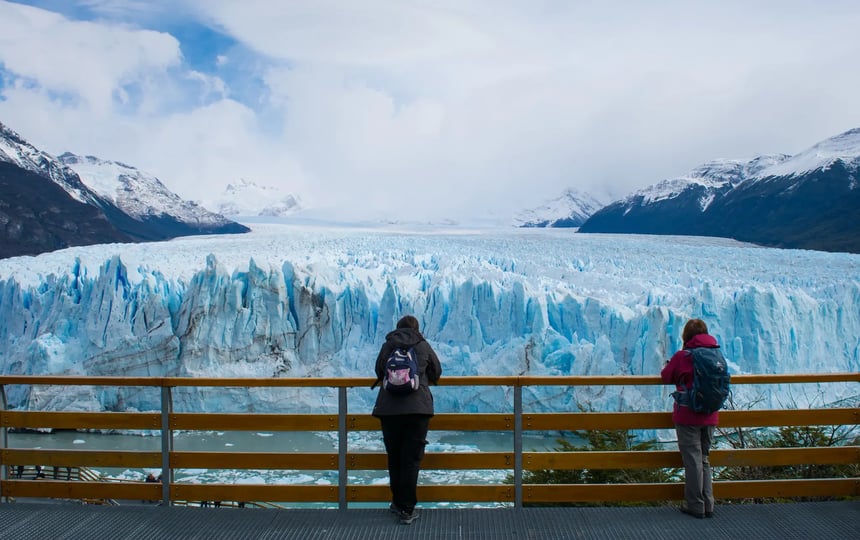Did you know that there are 17,300 glaciers in Patagonia?
According to National Geographic, that is the number of glaciers spread across the Northern Patagonian Ice Field and the Southern Patagonian Ice Field combined. This natural spectacle is fascinating for scientists, but it is also a travel destination, easily accessible by hiking, boating, or even kayaking. However, these majestic ice formations are tragically under threat due to climate change. Hence, there is a sense of urgency to witness them before they diminish, all while maintaining respect for the environment.
What exactly is a glacier?
The National Snow and Ice Data Center describes a glacier as: "an accumulation of ice and snow that slowly flows over land. (...) Glaciers begin to form when snow remains in the same area year-round, where enough snow accumulates to transform into ice. Each year, new layers of snow bury and compress the previous layers."
The vast amounts of ice are an impressive natural phenomenon you can only experience by seeing, smelling, and feeling. Enter Chile and Argentina, the places to be!

Where can you find glaciers?
Patagonia has two major continental ice sheets: the Northern Patagonian Ice Field (1,600 square miles/4,200 square kilometers) and the Southern Patagonian Ice Field (5,000 square miles/13,000 square kilometers). These ice fields were once part of an even more enormous expanse, reaching its peak around 18,000 years ago. Let's delve a bit deeper into the southern region!
Most of the Southern Patagonian Ice Field lies within Chilean territory, and approximately 15% is in Argentina. This ice cap is the second-largest after Antarctica and Greenland, stretching 350 kilometers. Among some of the most popular glaciers are:
- Pío XI Glacier in Bernardo O’Higgins National Park, Chile
- Glaciers Grey, Balmaceda and Serrano in Torres del Paine, Chile
- Upsala, Viedma and Perito Moreno in Los Glaciares National Park, Argentina
Is it just snow and ice?
The Southern Patagonian Ice Field presents a varied landscape, encompassing rocky formations, winding rivers, and cascading ice masses. This blend of terrain creates a dynamic environment for exploration and observation.

Can you visit the glaciers?
Despite the rugged terrain making access challenging in certain areas, there are numerous ways to experience the landscapes of the glaciers, even during the winter months. You can hike to a viewpoint, be adventurous during an ice hike over the surface equipped with crampons, paddle around in a kayak, or join boat tours and cruises.
You can enjoy a 4-day glacier excursion in Argentinian Patagonia, where you will get different perspectives on the Perito Moreno and Upsala glaciers and discover Los Glaciares National Park. Check out our programs here: Glaciers Winter Experience and Perito Moreno & Upsala Glacier Explorer.
If you plan to hike the Circuit Trek (O Trek) in Torres del Paine, seize the opportunity to kayak around the enormous floating icebergs of the Grey Glacier between November and mid-March. Our variant of the W Trek, W Brush, offers the chance to see the glaciers Grey, Balmaceda, and Serrano along the route.

How does climate change affect Patagonia's glaciers?
In 2022, UNESCO warned that 460 glaciers worldwide will disappear by 2050 due to the effects of climate change.
While fluctuations in glacier size are expected in response to seasonal changes, the acceleration of melting rates has become a concerning trend driven by a rising global temperature. According to Chile's DGA (Dirección General de Aguas) in 2022, the glacial surface has been fragmented during the past 15 years, and 8% of the total ice volume in Chile has been lost.
In an article* published by NASA Earth Observatory, Eric Rignot, a glaciologist, states: "The Patagonian icefields are, in fact, melting away at some of the highest rates on the planet. The reason is that they are not only melting from the top because of warm air but also from below, where they come in contact with ocean and lake waters."
Would you like to know more about climate change and the consequences for Patagonia's glaciers? Chilean explorer Christian Donoso captured it in photos.
Ready for a trip? Book your excursion in Argentina or Chile!
*source: https://earthobservatory.nasa.gov/images/90464/south-patagonian-icefield















